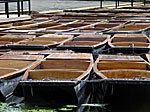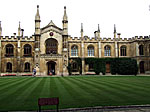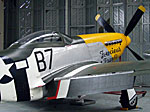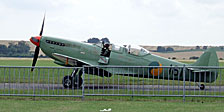Frank's travels around Britain 2006.
Cambridge & Duxford
Air Museum.
 I
found Cambridge much nicer than Oxford. It was easier to get round, better to
park & the shops seem to be kept in designated areas. The River Cam & punting is big
business. A punt is a
flat-bottomed boat with a square-cut bow, designed for use in small rivers or
other shallow water. The punter generally propels the punt by pushing against
the river bed with a pole. Punts were originally built as cargo boats or
platforms for fowling and angling but in modern times their use is almost
exclusively confined to pleasure trips on the rivers in the university towns of
Oxford and Cambridge in England and races at a few summer regattas on the Thames
I
found Cambridge much nicer than Oxford. It was easier to get round, better to
park & the shops seem to be kept in designated areas. The River Cam & punting is big
business. A punt is a
flat-bottomed boat with a square-cut bow, designed for use in small rivers or
other shallow water. The punter generally propels the punt by pushing against
the river bed with a pole. Punts were originally built as cargo boats or
platforms for fowling and angling but in modern times their use is almost
exclusively confined to pleasure trips on the rivers in the university towns of
Oxford and Cambridge in England and races at a few summer regattas on the Thames
Drawing on its links with the University, the Cambridge area
today is sometimes referred to as Silicon Fen, due to the growth of high tech
businesses and technology incubators that have sprung up in the series of
science parks and other developments in and around the city. Such companies
include Acorn Computers and Sinclair. The University was joined by the larger
part of Anglia Ruskin University, and the educational reputation has led to
other bodies (such as the Open University in East Anglia) basing themselves in
the city.
 Typical of me, I was talking to a family in the Little Chef
and asking what they'd seen. The dad said
"Why not go to the Imperial War Museum?" Of course, I thought it was in London.
It was a lucky break to find out it was two junctions down the road was Duxford
Air Museum! Ok it was expensive at £11 for a pensioner, but what a great place
to wallow in anything that flies!
Duxford's American Air hanger was designed by Norman Foster, and opened by the
Queen in August 1997. It contains Duxford's collection of American military
aircraft from First World War biplanes to supersonic jets. It is a tribute to
American air power and a memorial to the 30,000 US airmen who lost their lives
flying from British bases during the Second World War. It really is a credit to the country. Beautiful built, superbly stocked
with immaculate exhibits. To see how they fitted things round a B52 was worth
seeing alone
Typical of me, I was talking to a family in the Little Chef
and asking what they'd seen. The dad said
"Why not go to the Imperial War Museum?" Of course, I thought it was in London.
It was a lucky break to find out it was two junctions down the road was Duxford
Air Museum! Ok it was expensive at £11 for a pensioner, but what a great place
to wallow in anything that flies!
Duxford's American Air hanger was designed by Norman Foster, and opened by the
Queen in August 1997. It contains Duxford's collection of American military
aircraft from First World War biplanes to supersonic jets. It is a tribute to
American air power and a memorial to the 30,000 US airmen who lost their lives
flying from British bases during the Second World War. It really is a credit to the country. Beautiful built, superbly stocked
with immaculate exhibits. To see how they fitted things round a B52 was worth
seeing alone
I was lucky enough to see The "Grace Spitfire" - ML407, a T Mk IX that is privately owned and operates out of Duxford.
The Grace Spitfire History... taken from their website.
 The
Grace Spitfire was originally built at Castle Bromwich in early 1944 as a single
seat fighter, and served in the front line of battle throughout the last twelve
months of WWII, with six different Squadrons of the RAF's 2nd Tactical Air
Force, all in all flying 176 operational combat sorties. It was delivered to 485
New Zealand Squadron on the 29th of April 1944 by Jackie Moggridge, one of the
top lady pilots of the ATA, where it became the 'mount' of Flying Officer
Johnnie Houlton DFC who was accredited, whilst flying ML407, with the first
enemy aircraft shot down over the Normandy Beach head on D-Day.
The
Grace Spitfire was originally built at Castle Bromwich in early 1944 as a single
seat fighter, and served in the front line of battle throughout the last twelve
months of WWII, with six different Squadrons of the RAF's 2nd Tactical Air
Force, all in all flying 176 operational combat sorties. It was delivered to 485
New Zealand Squadron on the 29th of April 1944 by Jackie Moggridge, one of the
top lady pilots of the ATA, where it became the 'mount' of Flying Officer
Johnnie Houlton DFC who was accredited, whilst flying ML407, with the first
enemy aircraft shot down over the Normandy Beach head on D-Day.
In December of 1944, ML407 was transferred to 341 Free French Squadron,
becoming the aircraft of Sergeant Jean Dabos. It then moved on through 308
(Polish) Squadron, 349 (Belgian) Squadron, 345 (Free French) Squadron, 332
(Norwegian) Squadron, and back to 485 (New Zealand) Squadron, before being
remodelled as a 2-seat trainer for the Irish Air Corps where she flew until
1960.

She was used for the film 'Battle of Britain' and was then sold to the Strathallan Museum from where she was acquired by engineer Nick Grace in 1979. Nick spent five years meticulously restoring the Grace Spitfire to flying condition as a 2-seat Spitfire, and completed this incredible project in 1985, when, on the 16th of April, the Grace Spitfire flew again, with Nick's capable hands at the controls. Nick went on to fly it at many air displays and for filming, including 'Perfect Lady' and 'Piece of Cake'. A cruel twist of fate occurred when Nick Grace was tragically killed in a car accident in 1988, and his widow Carolyn Grace took on the task of learning to fly the Spitfire, which you can find documented in the film 'Going Solo'. Carolyn, as can be seen in the film, successfully completed her training by 'going solo' in the Spitfire in 1990, and hasn't looked back since, getting her Display Authorisation in 1991, and adding Aerobatic and Formation qualifications to that since.
The Spitfire is kept in Hangar Two at the Imperial War Museum in Duxford, Cambridgeshire, UK, and is maintained by Chief Engineer Dave Payne and his team. Carolyn flies the Grace Spitfire at many air shows, both public and private, up and down the country, and even in Europe, having also flown, much to her credit in no less than five record-breaking Spitfire formation flypasts between 1996 and 2000.
Links for information on this page:
